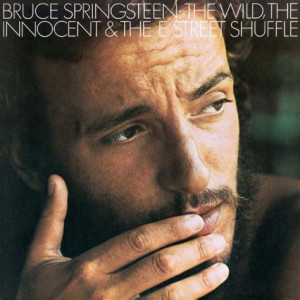
Published on Dec 12, 2001
Sometimes, an artist comes along and surprises you with an album
that’s completely out of left-field; so it was with me and Bruce
Springsteen, when I bought this album. I’d only heard
Nebraska,
The River and
Greetings From Asbury Park, N.J. when this album came my way
– it’s so different from them that only Springsteen’s voice and
lyrics can convince the listener that, yes, this is the same guy
that brought you “Johnny 99” and “Hungry Heart.”
This album begins with an homage to the oh-so-famous “tune up”
segment of every orchestral concert, which is quite an apt way of
sending home the fact that this album is full of lush arrangements
and grandiose themes. A quick guitar line calls the troops into
line, and then we’re given a funk-style song with Springsteen
deftly navigating over top of the music with more of his
fully-automatic lyrics. The ending to this song, “The E Street
Shuffle,” is a tour-de-force of Santana-esque rhythms, direly funk
horn arrangements and guitar.
“Sandy” is a delightful piece of music, even if I do now prefer
the
Live 1975-1985 version more. It’s a quiet serenade from one
friend to another – desperately hoping that this, his last night in
his hometown, will be special with someone he has grown to love.
It’s not about undying love, or about a one night stand, but
somewhere in the middle. It’s about two friends who love each
other. For a distinctly beautiful segment, listen carefully to the
toy piano notes underneath Springsteen’s voice starting with “The
waitress I was seeing…”
I hated “Kitty’s Back” for the longest time. I didn’t like the
opening guitar solo, and the rest of it just seemed to go on for
too long. Sometime over the summer, however, I put it in the CD
player at work, and it just hooked me – the screaming guitar,
actually saying something with its notes, the horns underneath it
helping it to conclude, and the gentle keyboards under the opening
vocals all combined to bring the listener to the top of a crest,
when suddenly the uptempo rhythm speeds them down the hill.
As soon as that hill starts, it doesn’t stop – we’re given
momentary respite occasionally, but the intensity remains.
Somewhere in the background the drums are going maniacally, the
guitar is picking all over the place, and Springsteen is shaking
his head with his eyes closed, “Oooh, what can I do, oo-ooh, what
can I do…” This song is one of the most complicated arrangements
I’ve ever heard, with guitar and keyboard dueling like a Ritchie
Blackmore nightmare, horns exploding left and right, and drums
banging like a psychotic Buddy Rich. Through all of this, however,
the music never loses its essential groove, which is definitely a
tough task to do. I could write novels about this one song – it’s
so filled with different ideas, accomplishments, emotions and
feelings that it speaks to me deeply.
“Wild Billy’s Circus Story” is a fun little number, highlighted
by the tuba oom-paa. The accordion and guitar strumming work to
enhance this black comedy. I can imagine Springsteen standing at a
podium, telling this like a story, screaming left and right with
each verse – it’s very vividly done, with not a wasted word.
Here we are given momentary respite, as images of the band
getting ready for a long haul are called to mind. “Incident On 57th
Street” starts out with beautiful piano, then moves into a
story-telling mode, replete with piano, and the chorus doesn’t even
show up for what seems like an eternity. “The pimps swung their
axes / and said Johnny, you’re a liar!” The portrait here of life
on the street is optimistic, not jaded – as Springsteen would come
to be in later years. “Good night, it’s all right, Jane.” Around
four minutes in it takes a break, as our faithful narrator
delicately describes the scene in immense detail. Afterward, we’re
given a repeating chorus building up in strength until the
magnificent guitar solo at the end, fading into a piano outro.
Listen carefully for what sounds like metal guitar underneath
everything else just before the finale.
This segues directly into “Rosalita,” my clear favorite of the
album. This song is so full of life and joy, optimism and feeling,
and altogether it comes across as a song to listen to with the
windows down on a warm summer evening while driving to the beach.
The musicianship here is very tight, with everyone definitely in
sync with not only each other, but with the song itself. One of my
favorite musical tricks is simultaneous overdubs with different
weights; here Springsteen shouts one chorus underneath a singing
version. Despite the tone of the words, this song is uplifting and
inspirational.
“New York City Serenade” is a song that shifts between moody,
dwelling and uplifting and satisfying. It starts out with some
beautiful “doodling” on the guitar, moving into dark, almost
whispered lyrics, building up to strained vocal delivery over top
of what sounds like classical string arrangements. The mood shifts
suddenly into a not-quite happy, but certainly relaxing, sound.
Another transition, and we see ourselves in a gospel-style rush of
sound – and then back again. We’re given three clearly similar
ideas, telling of three different people, and they’re all very
uplifting but restrained.
This album is one of the classics of modern music. Everything
about it is perfect; from the delivery of the vocals to the choice
of instruments, even down to the cover art – Bruce looking
contemplative but optimistic. This is one of my desert island
discs; I’d be happy to drive a thousand miles with only this to
listen to. Even if you hate Bruce Springsteen, this album is a
must-have in any collection.